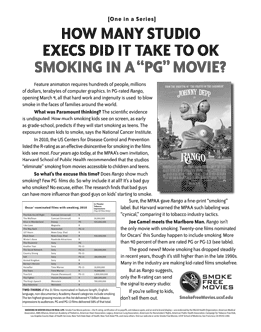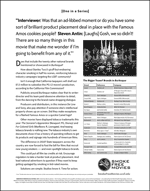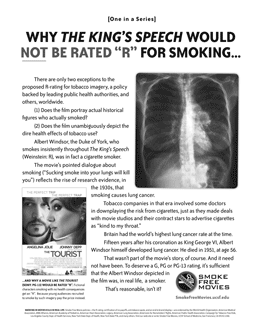February 23, 2011
Today Smokefree Movies ran a full page ad in Variety and Hollywood Reporter highlighting the fact that the new Paramount animated movie Rango, which will hit the theaters next week, on March 4, featured smoking. Given that the movie is a cartoon, the producers can's use the excuse that the actor insisted on smoking! Any smoking -- even in cartoons -- contributes to youth smoking.
See the full ad here.

February 2, 2011
The well regarded film, "The King's Speech" is filled with smoking. The MPAA rated it "R" for language because of one scene where the "f-word" wasrepeated several times as part of a speech therapy session, somethingthat I think was silly. Despite all the smoking, we would not haverated the film "R" for two reasons: (1) King George actually smoked (anddied of lung cancer) and smoking's negative consequences are clearlypresented (effects on the voicebox).
To see the full ad, click here.
January 12, 2011
 At a time that states are facing unprecedented deficits and making large cuts to education and other programming, they continue to spend billions of dollars subsidizing movies that promote smoking. We ran an advertisement in the January issue of State Legislatures magazine making this point.
At a time that states are facing unprecedented deficits and making large cuts to education and other programming, they continue to spend billions of dollars subsidizing movies that promote smoking. We ran an advertisement in the January issue of State Legislatures magazine making this point.
December 23, 2010
Jim Lightwood and I just published a new paper in Social Science and Medicine showing that, like the California program, the Arizona program had an immediate effect not only on smoking but also healthcare costs. Like California, the effect grew with time.
Interestingly, the Arizona program, which was weaker and more focused on youth that California, while highly cost-effective, was less cost-effective than the more aggressive California program.
So the bottom line is this: Large scale tobacco control programs work and contribute to short-term medical cost containment and more aggressive programs produce bigger benefits.
Here is the abstract:
December 20, 2010
 On January 1, California will start handing out tax credits for Hollywood film productions. Burlesque will be one of the first in line, set to receive $7,225,306 according to the state’s film commission. The problem from a public health standpoint? Burlesque is a PG-13 film with smoking by two major characters (Stanley Tucci, Kristen Bell). You’ll also glimpse a Camel logo, among at least twenty other alcohol, cookie, cereal and other nationally-advertised brands. Our ad in Variety this week quotes the film’s writer/director wondering if he’ll benefit from all the commercial name dropping. We politely point out that smoking in kid-rated movies could cause regulators to question product placement in general, make advertisers screen films for smoking before getting on board, and make it harder for the major studios to claim hundreds of millions from taxpayers for what amount to 90-minute commercials. For a perspective on California’s film subsidies, see Dan Morain’s piece in The Sacramento Bee (Dec. 12).
On January 1, California will start handing out tax credits for Hollywood film productions. Burlesque will be one of the first in line, set to receive $7,225,306 according to the state’s film commission. The problem from a public health standpoint? Burlesque is a PG-13 film with smoking by two major characters (Stanley Tucci, Kristen Bell). You’ll also glimpse a Camel logo, among at least twenty other alcohol, cookie, cereal and other nationally-advertised brands. Our ad in Variety this week quotes the film’s writer/director wondering if he’ll benefit from all the commercial name dropping. We politely point out that smoking in kid-rated movies could cause regulators to question product placement in general, make advertisers screen films for smoking before getting on board, and make it harder for the major studios to claim hundreds of millions from taxpayers for what amount to 90-minute commercials. For a perspective on California’s film subsidies, see Dan Morain’s piece in The Sacramento Bee (Dec. 12).

